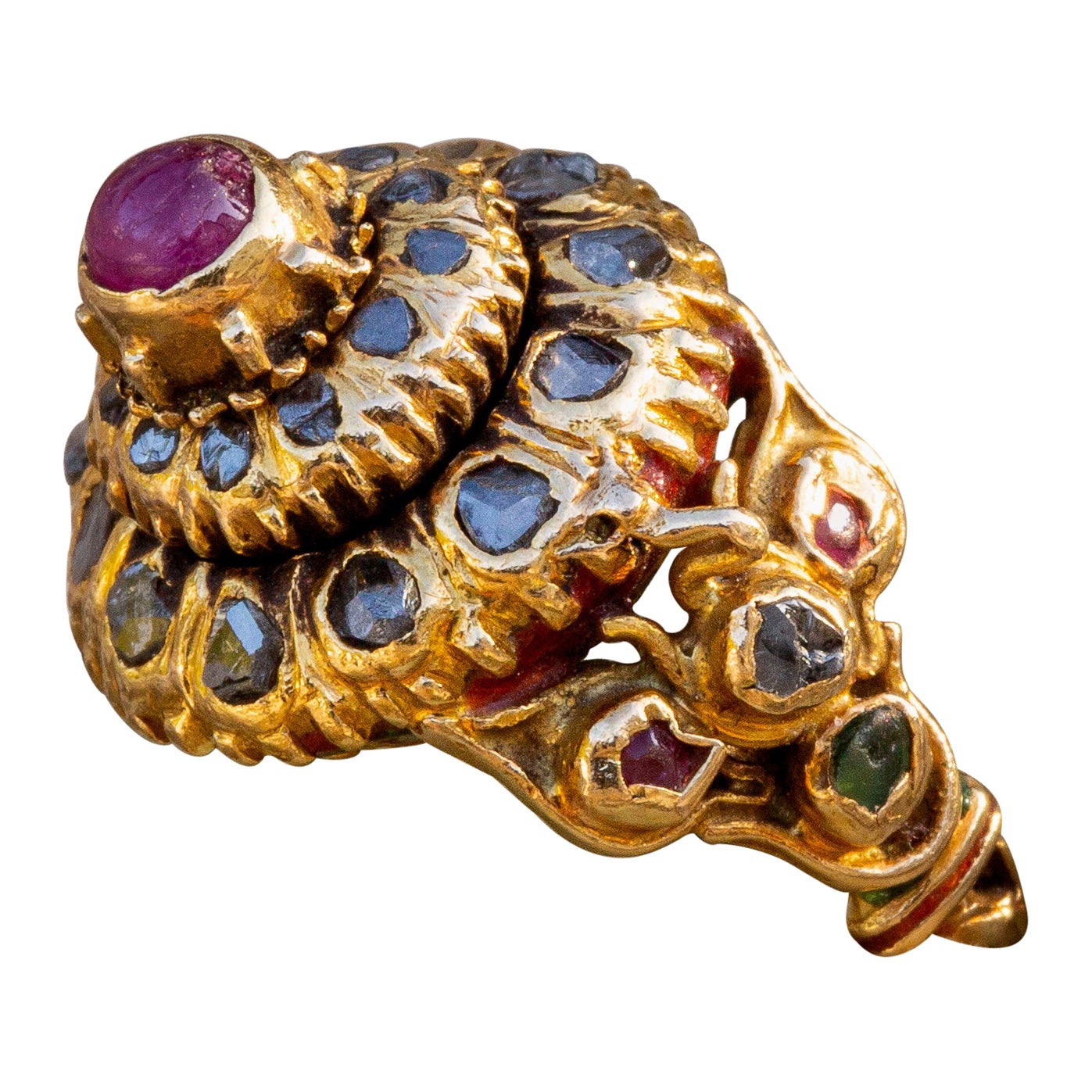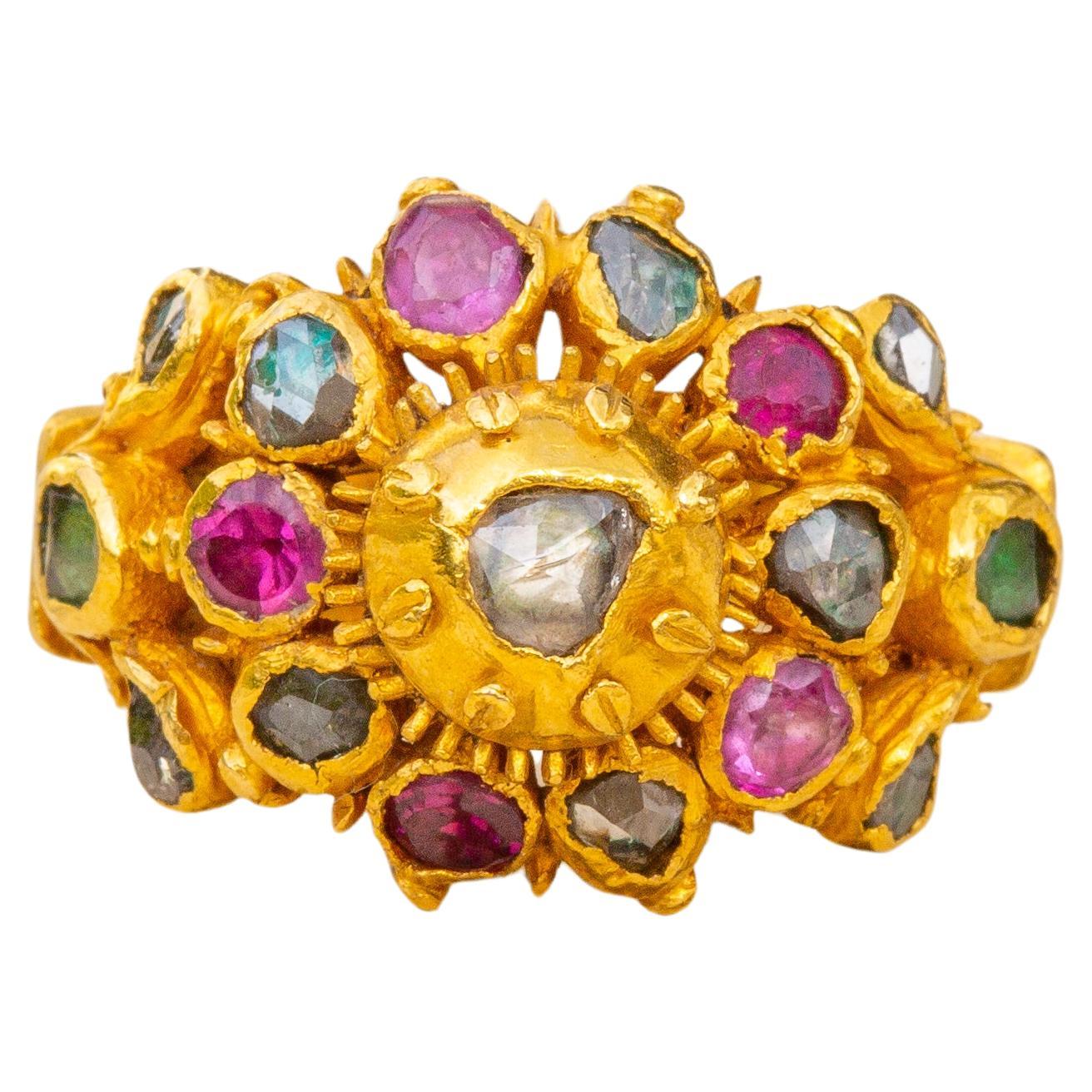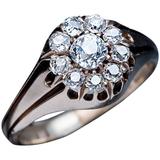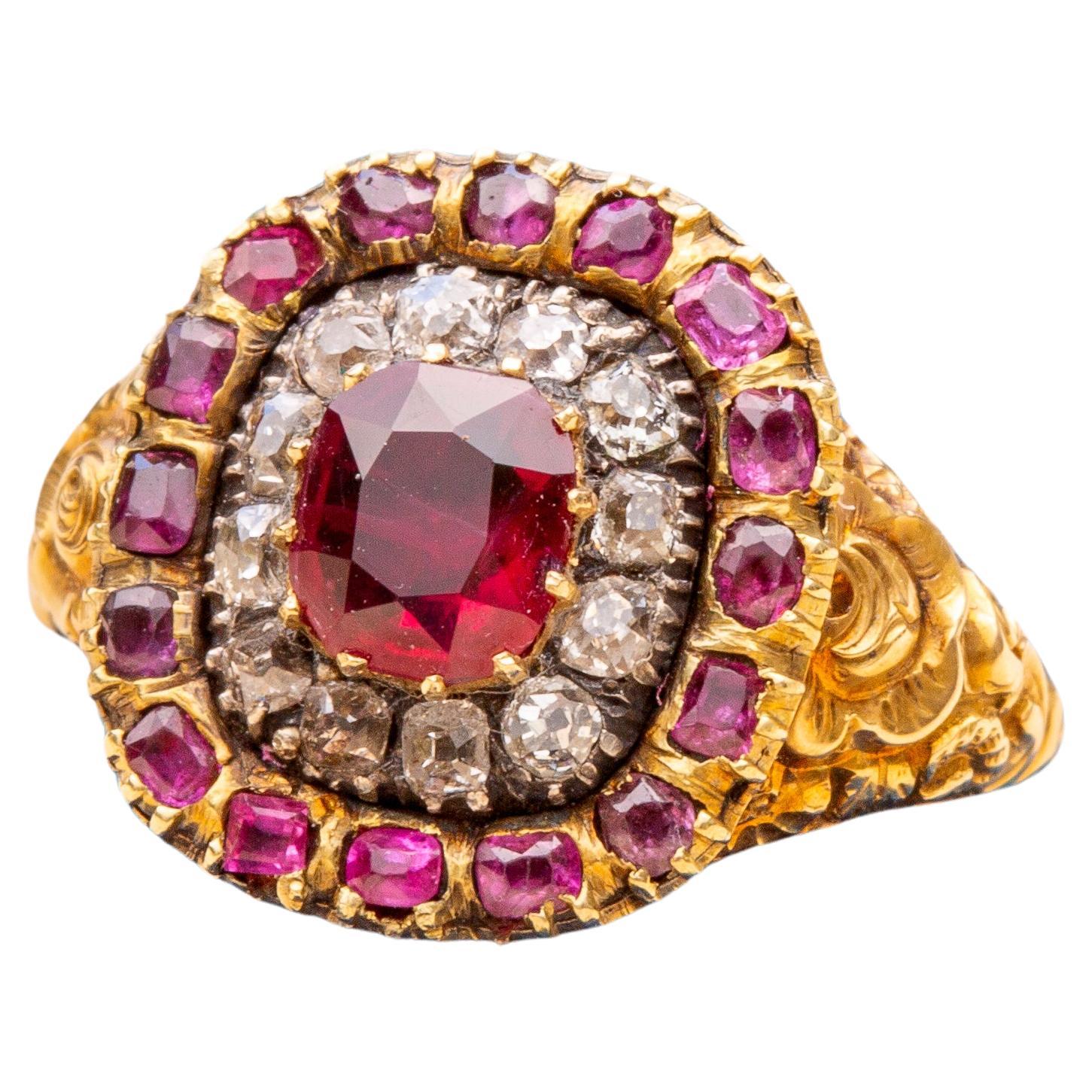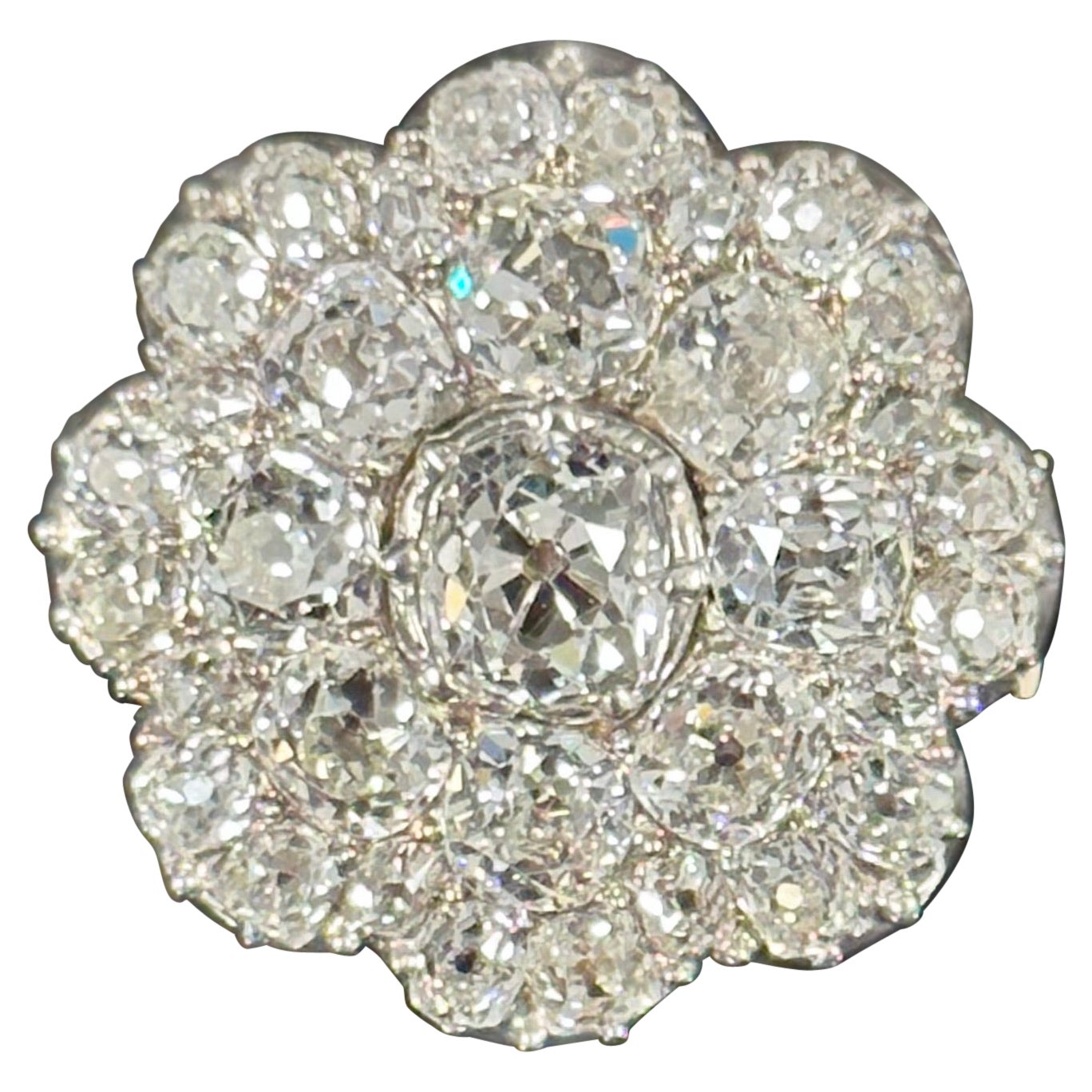Items Similar to Important 19th Century Royal Siam Diamond Cluster Ring Museum-Grade Thai
Video Loading
Want more images or videos?
Request additional images or videos from the seller
1 of 22
Important 19th Century Royal Siam Diamond Cluster Ring Museum-Grade Thai
About the Item
An outstandingly rare mid-19th century royal Siam diamond cluster ring, made by the royal goldsmiths of the court of Bangkok.
This is an extremely fine example of the jewellery commissioned and subsequently bestowed by the Kings of Siam, principally to be worn by participants in royal and aristocratic life-cycle ceremonies in the courts of Bangkok. In the mid-19th century, King Mongkut (Rama IV) of Siam also commissioned the courtly jewellers to create a number of faithful replicas of these ceremonial jewels to be offered as gifts to diplomatic families, important visitors and to Heads of State across the world when re-establishing diplomatic relationships. One such example (which is remarkably similar to the present ring) resides in the museum of the Château de Fontainebleau (item F1518C) where it was given as a gift from King Mongkut to Napoléon-III on the important ambassadorial visit of 1861 (see photos for a side by side comparison).
Ceremonial Use:
During the 19th century, many rings were made every year by the royal jewellers for ceremonial use. Examples of these lavish cluster rings being worn for these life-cycle ceremonies can be seen on old photos and paintings of the Royal Tonsure Ceremony, also known as ‘the cutting of the top-knot’ ceremony, which marked the transition from childhood into adulthood for all of the (many!) sons and daughters of the Siam royal family.
The huge expansion in the number of royals in 19th century Siam stemmed from Kings Mongkut (Rama IV) and Chulalongkorn (Rama V) being highly polygamous. They had a joint total of 124 wives and 159 royal children, each requiring their own ceremonial regalia and princely jewels. As a result, Bangkok became home to some incredibly skilled goldsmiths in this period. The Tonsure ceremony was performed by the King, and lasted three days and three nights. All of the royal children would be dressed in the most splendid costumes and adorned with a vast amount of jewels on several parts of the body. Their costumes and jewels differed according to their title and rank. Diamonds for instance, would be bestowed to the highest ranking noble children. The royal children were allowed to keep their regalia and jewels as a present on entering adulthood to indicate their social status among society.
Over the years, these royal jewels have been dispersed across the many noble families, with currently only a few important pieces remaining in the royal collection. Today, the number of royals in Thailand is contracting as the country follows the Chinese nobility system whereby with each generation the noble rank of a family decreases by one ranking so that eventually the majority of descendants will lose their noble status completely. This loss of royal privilege, coupled with the dilution of wealth has meant that items such as this ring become available on the open market. Following the end of the absolute monarchy in Thailand in 1932, many members of the royal family relocated to Europe and as a consequence, princely Thai items can occasionally be found in the European art market.
Gift Exchange:
In Siam culture, great importance is placed on the ancestral process of gift-exchange. During the reign of King Mongkut, close relationships with some powerful countries were cultivated in order to hold the balance of power and to save Siam from being colonised. The King used gift-exchange to establish diplomatic relations with other heads of state around the world, as well as with other kings, princes and sultans closer to home. He sent troupes of ambassadors to England (1857) and France (1861) with seemingly endless amounts of trunks filled with lavish gifts in order to dazzle the heads of state with the extraordinary quality and variety of Siam craftsmanship.
These gifts consisted of faithful replicas of the Royal Regalia and objects belonging to the King himself; items and jewellery worn by him on his Tonsure ceremony and on his coronation day. Enormous time and effort was required by the Siam court to assemble these numerous gifts, as they emanated from the very same royal goldsmiths and courtly craftsman who had made the original ceremonial items.
The most famous of these ceremonies took place at the Chateau de Fontainebleau in 1861. The painting by Jean-Léon Gérôme that immortalised the event prominently features the most spectacular of these gifts. Among the 150 gifts presented to Napoléon-III by the Siam ambassadors were two diamond-set rings, both of which are on display in the Musée du Chateau de Fontainebleau (item no. F1518C and F1519C). One of these rings is a rose cut diamond cluster and bears a striking resemblance to the ring we are offering. According to Bruley (2011), this ring, presented to Napoleon-III, was a faithful replica of the ring worn by King Mongkut on his own coronation day in 1851, which now resides in the Pavilion of Royal Regalia in Thailand.
The Ring:
From whichever angle the present ring is viewed, it is a masterpiece of design and a testament to the ingenuity and craftsmanship of the Siam royal goldsmiths. The bezel head is composed of two layers, the uppermost, containing the large triangle shaped table-cut diamond, is riveted to the main body of the ring. The second layer of the cluster is set with a further eight rose cut diamonds and this section allows for small rotation, typical of Siam jewellery of the period. The diamonds are all set in rubover and crimpled collet settings.
There is an applied floral motif on each shoulder with three further rose cut diamonds. The band features an intricately engraved scrollwork pattern with ornately pierced openwork sections. The underside of the bezel is in itself a work of art, and without doubt the most beautiful we have ever seen. It takes a floral form, possibly depicting a lotus flower. The ring is crafted in solid 21.6K gold and weighs an impressive 15.81 grams. The particularly high karat gold composition of this ring means that the gold surface tarnishes at a very slow rate thereby retaining its alluring shine and bright yellow colour.
Size: UK size N, US size 6.75
The outer band carries a French gold import control mark from when it was brought into the country at a later date, the mark indicating a minimum gold fineness of 18K gold. The 15 foil-backed diamonds are all set very securely and have an approximate total weight of 2.5cts. The circular section of the bezel measures 18mm across while the band measures 4mm wide at the back. The ring is in excellent overall condition with very minimal signs of wear. Under magnification, one notices some very light abrasions to the diamond facet junctions as well as a small surface scratch on one side facet of the central diamond.
This historically important ring, whether intended to be worn in ceremony, or to be gifted to an important foreign diplomat or visitor is undoubtedly the most unique piece of museum-grade jewellery we have had the fortune and privilege of handling. We were unable to find another example to ever sell at auction, and a comparable item may not appear on the market for many years to come.
A masterpiece from the most talented courtly goldsmiths of the 19th century.
Please get in touch if you have any questions.
Resources:
Bruley, Y., et al, Le Siam a Fontainbleau l’Ambassade du 27 Juin 1861, Chateau de Fontainbleau, 2011.
Richter, A., The Jewelry of Southeast Asia, Thames & Hudson, 2000.
Salmon, X., et al, Chateau de Fontainebleau: Le Musee Chinois de l’Imperatrice Eugenie, Chateau de Fontainebleau, 2011.
- Creator:Royal Goldsmiths of Bangkok
- Ring Size:6.75 US, Not Resizable
- Metal:
- Stone:
- Stone Cut:
- Weight:15.81 g
- Style:
- Place of Origin:
- Period:
- Date of Manufacture:1850
- Condition:
- Seller Location:London, GB
- Reference Number:1stDibs: LU2845221230252
About the Seller
5.0
Vetted Seller
These experienced sellers undergo a comprehensive evaluation by our team of in-house experts.
Established in 2019
1stDibs seller since 2022
32 sales on 1stDibs
Typical response time: 11 hours
- ShippingRetrieving quote...Ships From: London, United Kingdom
- Return PolicyA return for this item may be initiated within 14 days of delivery.
More From This SellerView All
- Royal Siam 'Thai' Museum-Grade 18th Century Ayutthaya Ceremonial RingLocated in London, GBThis incredibly ornate piece was made in Siam during the late Ayutthaya or early Rattanakosin Kingdom period. It dates to the late 18th and is a very rare example of a ceremonial ‘mondop’ or ‘pagoda’ ring. These rings were made for the monarchy and aristocratic class of Siam to be worn as part of the lavish adornment paraphernalia used in ceremonies. These elaborate rings were subsequently given as gifts to important visitors or other aristocratic families. A similar example is found in Musée National du Château de Fontainebleau and was originally presented to Napoléon-III by the ambassadors of King Mongkut of Siam (Rama IV) alongside hundreds of other lavish gifts in order to re-establish diplomatic relations between France and Siam in 1861. Among these gifts are old jewels from King Mongkut’s treasury, including the gold diamond mondop/pagoda ring (see photos). During this visit, the son of the Siamese ambassador, Khoumsombat, is photographed wearing a very similar tiered mondop ring with what also appears to be a ruby cabochon at the top (see photos). A ‘mondop’ is the tiered roof of a temple, for example that of Wat Phra Kaew in Bangkok, and is designed to be in the shape of the image of Buddha. The top tier of this ring features a bezel set star ruby cabochon while the rest of the bezel is covered with diamonds. The two outermost tiers rotate and are connected to the main body of the ring with a bifurcated rivet visible on the closed-back underside of the bezel, typical ornamentation of 18th century layered cluster rings. The arched shoulders are equally as ornate with bezel set rub over diamonds, emeralds and rubies appearing between foliate motifs and protruding serpent-esque decoration. The underside and outershank display bright red and green floral enamelling often seen on naga rings...Category
Antique Late 18th Century Thai More Rings
MaterialsDiamond, Emerald, Ruby, 22k Gold
- Antique Thai Siam 19th Century Gold Princely Gem-Set Cluster Ring Ruby EmeraldLocated in London, GBA rare late 19th century gem-set princely gold cluster ring made in Siam (Thailand). This gorgeous and colourful gem-set cluster ring is intricately crafted in high-karat gold, by t...Category
Antique 19th Century Thai Cluster Rings
MaterialsDiamond, Ruby, Emerald, Gold
- Antique Thai Siam 19th Century Gold Rose Cut Diamond and Ruby Garuda Bird RingLocated in London, GBA rare late 19th century gem-set princely gold ring made in Siam (Thailand). The ring takes the form of a mythical winged bird, possibly the Gar...Category
Antique 19th Century Thai Cluster Rings
MaterialsDiamond, Ruby, Gold
- Antique Georgian Early 19th Century 1ct Ruby and Diamond Target Cluster RingLocated in London, GBA superb antique Georgian ruby and diamond ring made in England, circa 1820. The centre of this ‘target’ shaped cluster ring is set with a 1ct cushion cut deep red ‘pigeon’s blood’ r...Category
Antique Early 19th Century English Georgian Cluster Rings
MaterialsDiamond, Ruby, 22k Gold
- Antique French Early 19th Century Emerald and Rose Cut Diamond Gold Cluster RingLocated in London, GBThis unusual antique emerald and diamond ring was made in France and dates to the early 19th century. In the centre rests a vibrant 0.3ct step cut emerald in an open-backed rubover silver setting. The stone is a wonderful vivid green colour and sits majestically within a halo of rose cut diamonds in closed-back and foiled rubover settings. The triangular facets of rose cuts were very popular during the Georgian and Victorian periods as they glistened more beautifully in candlelight than any other cut. The central cluster rests in a ‘belcher’ setting with 8 u-shaped curves to create a petal like design. The mount, crafted in 18K gold, is intricately engraved with foliate design and tapers towards the back of the ring with a D-shaped cross section. UK size T, US size 9.5. The ring weighs 7.03 grams, it is unmarked but tests as 18K gold. The ring is in good overall condition condition and the stones are securely set. There is some light wear to the gold as expected with rings of the age. The emerald displays a great colour with lots of natural inclusions; upon magnification, there is also a scratch to one of the corners of the table. The rose cut diamonds measure 2.5mm x 2mm across. The silver cluster measures 10mm in diameter. The ring sits fairly flat on the finger to allow for frequent wear, and the emerald is open-backed which makes it easy to clean! A truly gorgeous and highly unusual antique emerald cluster ring.Category
Antique Early 19th Century French Georgian Cluster Rings
MaterialsDiamond, Emerald, Gold
- Antique Mid-19th Century, French 18K Agate and Rose Cut Diamond Cluster RingLocated in London, GBThis stunning antique cluster ring was made in France and dates to around the mid 19th century, circa 1860. In the centre rests a smooth banded agate in an open back setting, encircled by a halo of rose cut diamonds in closed-back, cutdown silver settings with a combined approximate weight of 0.15 carats. The ring has a decorative pierced gallery in the form of crescents and a solid semi-circular shank. The shoulders are decorated with two applied fleur-de-lis, each set with rose cut diamonds in silver settings. The main colour of the milky agate is a creamy-brown hue with a darker brown band on one side. The diamonds are rose cut, the triangular facets of these cuts were very popular during the Georgian and Victorian periods as they glistened more beautifully in candlelight than any other cut. This elegant ring sits flat on the finger, the stones are secure in their settings and the ring is in superb condition despite its significant age, a truly rare find! UK size U / US size 10, 5.44g, French ’tête...Category
Antique Mid-19th Century French Victorian Cluster Rings
MaterialsAgate, Diamond, 18k Gold
You May Also Like
- 19th Century Antique Diamond Gold Men’s Cluster RingLocated in Chicago, ILMade in Moscow between 1882 and 1898 A classical Victorian era 14K gold cluster ring is centered with a sparkling bright white antique cushion cut diamond (measuring 4.7 x 4.7 x 3...Category
Antique Late 19th Century Russian Victorian Cluster Rings
MaterialsDiamond
- Antique 19th Century Old Mine Diamond Floral Cluster Cocktail Ring Silver GoldLocated in Lisbon, PTAntique 19th Century Old Mine-cut diamond floral cluster cocktail ring in silver and yellow gold, Europe, circa 1880s. This antique jewel is modelled as a scalloped flower, with a wide and bold circular design with scalloped borders, this ring features a larger Old Mine-cut diamond in a step-down collet setting surrounded by two rows of 32 similarly-cut pave-set diamonds, all stones in closed-back silver; the closed-back collet attaches to a later D-shape shank in yellow gold with raised shoulders, which can be removed. This dress ring features extremely fiery stones which are ready to sparkle day and night and is sure to make an extraordinary conversation starter! Diamonds: estimated 6.40 carats in total; main diamond estimated 1.20 carats, G/H color (assessed), VS1 clarity (assessed); remaining diamonds estimated 5.20 carats in total. Dimensions: 2.5 x 2.5 cm (collet face-up). Finger Size: 51 (EU) but it could be sized up or down. Gross weight: 12.59g. Finger size: 51 (EU), but could be sized up or down). This item is in good condition, with marks and scratches consistent with general age and wear. Antique, period and vintage pieces, both signed and unsigned, are being offered as worn. Unless otherwise stated, all weights and quality factors have been graded as mounting permitted and using classic gemology and standard gemological equipment and might slightly differ from the assessments provided by other gemologists. Assessments related to period of manufacture or geographic origin of gemstones are expert opinions and may differ from the assessments provided by other professionals. Colors in the pictures/videos might slightly differ from the colors in real life. When certificated stones are being offered, the certificate or report will be mentioned. For additional information or clarification, please get in touch and our in-house team of expert GIA Graduate Gemologists and Registered Appraisers/Valuers will be happy to help. Upon request, every item sold by Espadim 1985...Category
Antique 1880s Unknown Victorian Cocktail Rings
MaterialsDiamond, Gold, Yellow Gold, Silver
- Important Yellow Sapphire and Diamond Cluster Brooch/RingLocated in London, GBAn Important Victorian yellow sapphire and diamond brooch/ring, the natural sapphire weighing 31.58 carats, accompanied by GCS Re...Category
Antique Late 19th Century British Late Victorian Cluster Rings
MaterialsDiamond, Yellow Sapphire, 18k Gold, Yellow Gold, Silver
- Natural Unenhanced Siam Ruby and Diamond Cluster Ring, circa 1960Located in London, GBVintage ruby and diamond coronet cluster ring. Set with a natural unenhanced cushion shape old cut Siam ruby to centre in an open back yellow gold claw setting with an approximate we...Category
Vintage 1960s Cluster Rings
MaterialsDiamond, Ruby, Platinum, Yellow Gold
- 3.0tcw Royal Sapphire & Diamond Cocktail Cluster RingLocated in Jupiter, FLFeatured here is a sapphire & diamond statement ring/right hand ring. This ring is made in solid 14K yellow gold and displays 3.0 total carat weight in natural gemstones. Blue sapphi...Category
1990s American Modern Cocktail Rings
MaterialsDiamond, Sapphire, 14k Gold, Yellow Gold
- French 19th Century 18 Karat Rose Gold Chrysoberyl Cat's Eye Cluster RingLocated in Poitiers, FRRing in 18 karats rose gold, horse's head hallmark. This beautiful marquise ring is set with claws of an oval cabochon cat's eye surrounded by rose-cut diamonds. Total weight of the ...Category
Antique Late 19th Century French Napoleon III Engagement Rings
MaterialsChrysoberyl, Diamond, White Diamond, Gold, 18k Gold, Rose Gold
